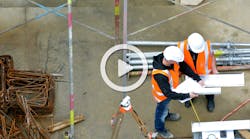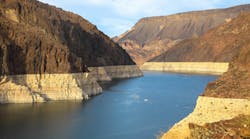This is the second installment of a two-part article. Read Part 1, Building BMPs to Last.
Manufacturers have maintenance programs in place to keep their equipment running and downtime to a minimum; distributors roll out preventative maintenance programs on their automated conveyors and shuttles to ensure workplace safety and operational continuity, and fleet owners perform regular maintenance and repair checks to ensure that their vehicles are operating safely and efficiently.
The same attention to maintenance isn’t always given to stormwater storage structures. In fact, once buried in the ground, these valuable assets are often left unattended until their performance lags or they fail entirely.
“All stormwater management systems, whether gray or green, require maintenance,” says EPA. Appropriate operation and maintenance activities ensure that green infrastructure will continue to function properly and yield expected water quality and environmental benefits, protect public safety, meet legal standards, and protect communities’ financial investment.”
These elements outlined by the EPA should be considered early in the stormwater structure design process, knowing that the choice of materials, structure, and setup can all impact the system’s ongoing maintenance requirements. In return, municipalities and private owners get an asset that withstands the test of time, meets code requirements, and provides a safe, clean, efficient work environment for the individuals who maintain it.
Designing with Maintenance in Mind
For stormwater infrastructure projects to properly capture and infiltrate stormwater and perform as expected, EPA offers these key factors to consider before project implementation, including
- the type of maintenance to be performed;
- the frequency of maintenance;
- available personnel to perform maintenance;
- the cost of component replacement (e.g., plants, shrubs, permeable pavement); and
- whether there are sufficient and dedicated funds to cover operation and maintenance activities (including the cost of replacement components).
Who’s Responsible?
On most projects, the financial responsibility of maintaining stormwater structures both short- and long-term either falls on the shoulders of the private project owner or the municipality. Regardless of where the responsibility lies, the cost of neglect will always far outweigh the cost of proactive, ongoing maintenance. And while staying compliant with maintenance code requirements is a driving factor behind the need to maintain the structures, there are many other factors to take into consideration when designing and implementing stormwater structures.
“When a stormwater structure falls into disrepair due to funding issues or because it’s been neglected, it can be pretty expensive to fix and maintain,” says Hohnbaum. The accumulation of sediment and debris over a six-month period, for instance, can be enough to create a hefty cleaning or repair bill. Even worse, the neglect could prevent the structure from infiltrating—an issue that could lead to a much larger problem down the road. “When stormwater structures are allowed to fail,” Hohnbaum warns, “the whole system could potentially need to be retrofitted, removed, or even replaced.”
“At the end of the day, it’s the responsibility of whoever owns the structure to pay for it, but I’ve had scenarios where there’s an agreement between the developer and the city to where the latter takes the responsibility of maintaining it,” Justin Welham, a sales representative at United Storm Water Inc., in City of Industry, CA, says. “That’s usually set up during the permitting process and prior to construction.” Today, more cities are requiring a formal agreement during the turnover of ownership to ensure that the structure is maintained. “That hasn’t always been the case and it really depends on the site,” says Welham, “but we are seeing more of those types of arrangements.”
Pre-Treatment versus Post-Treatment
When it comes to stormwater storage systems, pre-treatment involves treatment upstream of the actual stormwater detention system (i.e., water coming down a channel through a pre-treatment device). This is the preferred solution both cost-wise and for the way it centralizes maintenance. “It’s easier to maintain and clean out those pre-treatment devices,” says Hohnbaum. “It also reduces maintenance costs.”
While it’s easier (and probably cheaper) to maintain one centralized, smaller pretreatment system than a larger “spread out” detention structure, providing a pre-treatment does cost more than post-treatment because the unit must be sized for the high intensity storm flow rate (versus a slower, reduced discharge flow rate).
For example, pre-treating for trash is both common and cost-effective because the flow rates for trash capture devices can be pretty high. Any pre-treatment for trash will capture some sediment, but complete pre-treatment for sediment at the storm flow rate isn’t always practical or cost effective. In fact, the most effective way to remove sediment from water is to just let it settle over time. The good news is that most large detention structures are designed to slow water down and hold it over a period of time, resulting in an ideal, cost effective way to remove sediment from the stormwater.
Stoke’s Law
Regardless of the pretreatment options, some sediment will stay in the water that reaches the detention structure and will settle to the bottom over time. According to Stoke’s Law, heavier or coarse sediment will fall out quickly (within the trash capture pretreatment device) while the smallest particles settle at a much slower rate (in the main detention system). To best leverage the varying settling rates, baffles can be incorporated into the structure to concentrate sediment to one or more smaller areas within the main structure. This, in turn, can help reduce the maintenance cost.
Removal of chemicals and microbes is both difficult and costly. As a result, both are usually dealt with during the slower post treatment discharge. However, many of these constituents bind to the sediment that fall out or settle in the main structure. For best results, the stormwater system should provide easy access to remove the sediment along with the bonded chemicals and microbes.
Welham says when it comes to removing sediment and debris, pre-treatment is the way to go. However, if you are trying to dial in water quality (e.g., by removing chemicals or microbes), that has to be handled post-treatment. “You can’t clean to the molecular level without removing the larger solids and other stuff first,” says Welham. “A lot of people are trying to figure out how to do this cost-effectively on a large scale.”
The Pros and Cons
Michael Kusch, Technical Resource Engineer with Foley Products Company in Murfreesboro, TN, says there are three different facets of stormwater structure maintenance: routine (random inspections and non-invasive cleaning); minor maintenance; and major maintenance (full system cleaning). “If things get too out of hand,” he says, “then you may even have to do a full system replacement.”
Whereas the need for maintenance may be obvious with an open system (e.g., an above-ground pond), it becomes less so when structures are buried underground. Sometimes, no one notices until it’s too late. One way to avoid high maintenance costs, unsafe environments, and damage to surrounding property is by selecting the right stormwater storage product at the outset. This helps eliminate rework and ensures a good match between the surrounding environment and the product.
In most cases, the main choices include plastic crates, pipes and domes, corrugated pipe galleries (plastic or metal), and modular precast concrete. Each of these options comes with its own pros and cons. Kusch points to a one half-round plastic stormwater structure in Kentucky that failed within two years of installation. It has since been replaced with a precast concrete underground detention system. “The original system clogged immediately because it lacked a good pre-treatment system,” Kusch explains. “Everything went into the chambers, so the system failed, over-deflected, and partially-collapsed.”
Another common maintenance issue for plastic pipe, dome, and chamber systems is that they all depend on water settling out and sediment being removed in one section of the pipe. Then, the assumption is that the rest of the pipe sections will remain clean. Unfortunately, that’s not what happens and—with no access for cleaning—those pipes just become more and more clogged until the system is rendered useless. Similar challenges can exist with corrugated metal pipe systems. For 1,000-feet of 5-foot diameter pipe, it is often challenging, if not impossible, for someone to get into and clean out the pipe.
Compared to plastic or corrugated metal pipe systems, concrete structures are generally large enough to allow someone to get down into them to perform maintenance. Any detention system that doesn’t provide safe, easy human access to inspect, maintain, and remove sediment will result in higher maintenance costs or complete loss of functionality over time.
According to Welham, pipe can also deteriorate over time, particularly those that feature felt or fabric-type systems. Kusch concurs and says perforated pipe systems or half-round systems that use a stone envelope as 40% of the void space to store the water can have their performance degrade as sediment settles into the voids.
On the other hand, precast concrete systems that don’t rely on rock for water storage allow sediment to settle onto a concrete floor, where it can be removed without compromising the function of the system. Concrete systems that feature an open format (versus a maze of compartments) are even easy to access and maintain, and precast concrete is durable and long-lasting.
“Concrete won’t wear away during the maintenance process,” says Welham. To ensure that a system will function over time, special care should be taken to prevent sediment from getting into the rock storage or rock bedding. Once the rock becomes clogged with sediment, the system will not work as designed.
Design with a Purpose
When designing or specifying stormwater structures, Hohnbaum tells engineers to pay attention to the ease of access for maintenance employees and equipment. Simply sinking a system into the ground and hoping that it lives up to expectations is the wrong approach. “Always consider the access points, knowing that many plastic systems have just a single monitoring port,” says Hohnbaum, “whereas with concrete structures, you can put multiple access points and manholes throughout the system for ease of access.”
Kusch says engineers should also factor in the activity taking place above their underground water detention systems, knowing that many are located under parking lots, buildings, and construction sites. “Heavy equipment presents one of the absolutely worst loads that any underground piping system will ever see. I think a lot of engineers forget that,” Kusch adds. “Instead, they’re designing for the end-use and not for how you get to the end.”
Mark Cuneo is a former city engineer for the cities of Santa Monica and Beverly Hills and is currently a project manager for a civil infrastructure contractor.
References
US EPA. Green Streets, Green Jobs, Green Towns (G3) Program. “Operation and Maintenance Considerations for Green Infrastructure. Accessed November 30, 2020. www.epa.gov/G3/operation-and-maintenance-considerations-green-infrastructure
About the Author
Mark Cuneo
Mark Cuneo is a former city engineer for the cities of Santa Monica and Beverly Hills and is currently a project manager for a civil infrastructure contractor.





